七年级上一般疑问句与特殊疑问句练习
- 格式:doc
- 大小:69.50 KB
- 文档页数:9
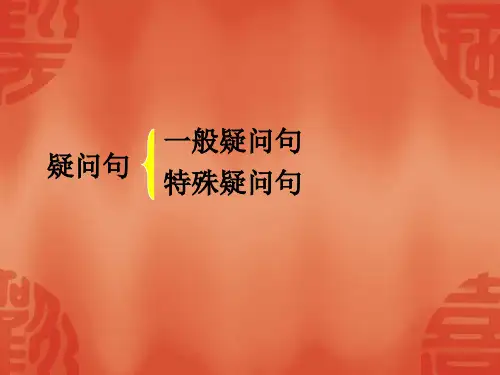

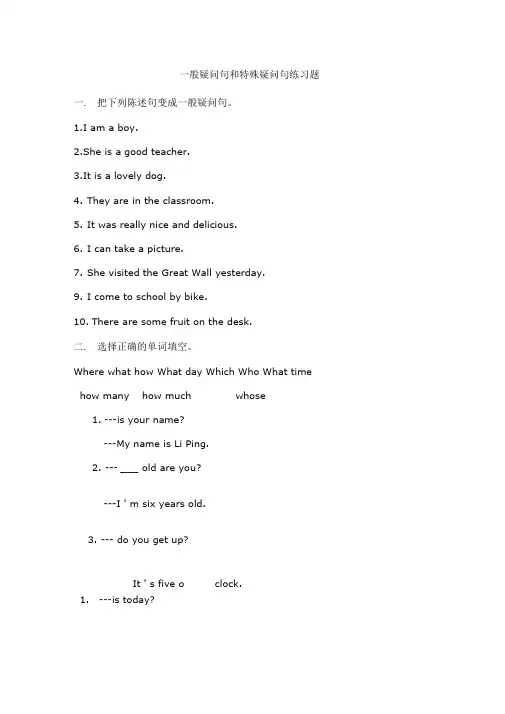
一般疑问句和特殊疑问句练习题一. 把下列陈述句变成一般疑问句。
1.I am a boy.2.She is a good teacher.3.It is a lovely dog.4.They are in the classroom.5.It was really nice and delicious.6.I can take a picture.7.She visited the Great Wall yesterday.9.I come to school by bike.10.There are some fruit on the desk.二. 选择正确的单词填空。
Where what how What day Which Who What time how many how much whose1.---is your name?---My name is Li Ping.2.--- ___ old are you?---I ' m six years old.3.--- do you get up?It ' s five o clock.1.---is today?---Today is Monday. 2.--one do you like best?--I like the black one. 3.—is she?---She is my teacher.4.---are you going?--- I ' m going to the store.5.--- are you!---I ' m fine.6.--- is it?--- It ' s five o ' clock.10. ---do you get here?---By bus.11.---are they?---They are 80 yuan.12.---books do you have?---I have two books13.---room is this?--- It ' s room.三. 对划线部分提问.1.I am going to Shanghai.2.My father will take me to Beijing.3.I went to here by bus.4.We send some beautiful flowers to our teacher.I 一般疑问句和特殊疑问句一.一般疑问句能用Yes或No回答的疑问句叫一般疑问句。

初一i英语一般疑问句和特殊疑问句讲解及练习Document serial number【NL89WT-NY98YT-NC8CB-NNUUT-NUT108】初一英语一般疑问句和特殊疑问句一般疑问句1.定义:用be或助动词或情态动词置于句首,并以“Yes,…”,或“No,…”或相当于yes/no回答的问句称为一般疑问句.2.含系动词be的一般疑问句的构成:具体地说,am只能跟在第一人称的单数I 后面,are搭配you,不管是单数还是复数,is跟在第三人称单数he,she后面Eg:I'minClass2,Grade1.→AreyouinClass2,Grade1?(如遇第一人称,最好将其置换成第二人称)It'samapofChina.→IsitamapofChina?这是一幅中国地图吗?AmIwrongagain?(我又错了)3.含情态动词的一般疑问句的构成一般疑问句面前人人平等:情态动词与am/is/are一样,也可直接将它们提至主语前,所以问题迎刃而解了。
如:Icanspellit.→Canyouspellit?你会拼写它吗?Willyoudothatforher?Canshedrive?4.含实义动词的一般疑问句的构成含实义动词的一般疑问句的构成稍微有点讲究,要在句首加do;如逢主语为第三人称单数,谓语动词为一般现在时单数第三人称形式"v-(e)s"时,用does,并要将谓语动词变回原形(如has→have,likes→like 等);有时陈述句中的some还要变作any等。
如:ShelivesinBeijing.→DoessheliveinBeijing?IlikeEnglish.→DoyoulikeEnglish?Therearesomebooksonmydesk.→Arethereanybooksonyourdesk?5.一般疑问句的应答用yes/no回答,并怎么问怎么答(句首为情态动词/am/is/are还是do/does),简略回答时要注意缩写(否定的n't)和采用相应的人称代词以避免重复:即"Yes,主语(代词)+情态动词或am/is/are或do/does."表示肯定;"No,主语(代词)+情态动词或am/is/are或者do/doesnot(n't)."表示否定。
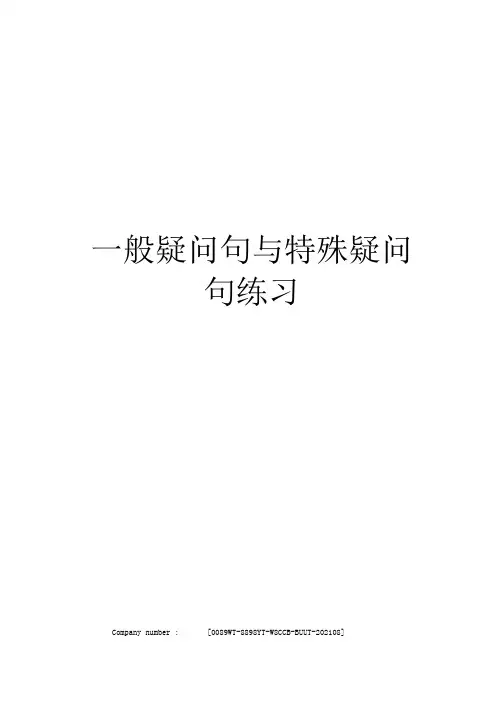
一般疑问句与特殊疑问句练习Company number : [0089WT-8898YT-W8CCB-BUUT-202108]巩固练习(一)She is quiz (改为一般疑问句)_He is very tall.(对划线部分提问)She^s very kind and preUy ・(对划线部外提问)Today is Saturcby.(对划线部分提问) ___ Is that a pen (作否定回答)__________ 10- Are the apples sour (作否定回答) _____17. Pork is my favourite food.(对划线部分提问). 1& There is a big closet.(改为否定句) 19. There are blue curtains.(改为一般疑问句)20. Is this your bedroom (改为复数形式) _____21. The shelf is near the desk ・(对划线部分提问)22. Are these your friends (作肯定回答) ___23. There are two curtains.(对划线部分提问) 24. It's a new desk ・(对划线部分提问) 25. Is it a walkman (作否定回答) 26- There is a small house in iny village.(改为复数形式)there a bke (作否定回答) _______________________are some buildings in our school.(改为一般疑问句). are some tall buildings in the city •(改为一般疑问句) there a river in your vi!lage (作肯定回答)is a bridge in my village.(改为复数形式) _______33, Are there any pandas in the inountains (作否定回答)34, There is a village.(改为一般疑问句)35. The flowers are 些1(对划线部分提问)36. He is our math teacher.(对划线部分提问)37. There is a student in the room/改为复数句子) 3& He's tall and thin.(改为一般疑问句) 39. Are2. 3. 4.5.6. Is Mr. Smith tall and strong (作肯定回答) Is this iny book (作否定回答) ______ She is young. She is pretty •(合并为一句)7. 9.they young(作肯定回答)40, is my father.(对划线部分提问)4L.They are under the tree•(对划线剖分提问)42・・The supermarket is near the school.(对划线部分提问)43..__________________________________________________ The computer is on the table.(对划线部分提问)______________________________________________44..The flowers are in the flower park(对划线部分提问)M feeling血1 .(对划线部分提问)_46.. My bag is型・(对划线部分提问)get up at six •(对划线部分提问)_ is a nurse •(对划线部分提问)are five yuan •(对划线部分提问)is my coat.(对划线部分提问)_______________________________一般疑问句与特殊疑问句巩固练习(二)将下列句子改为否定句,一般疑问句,并做肯定和否定回答。
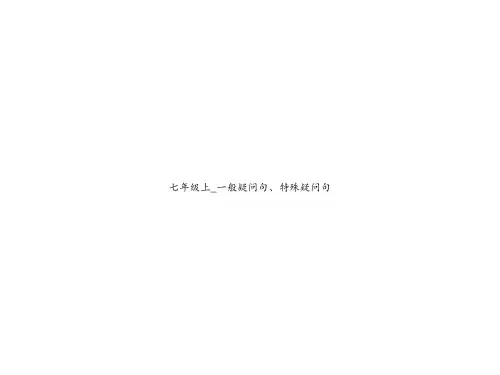
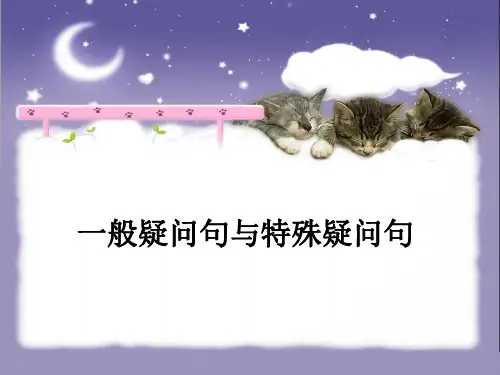
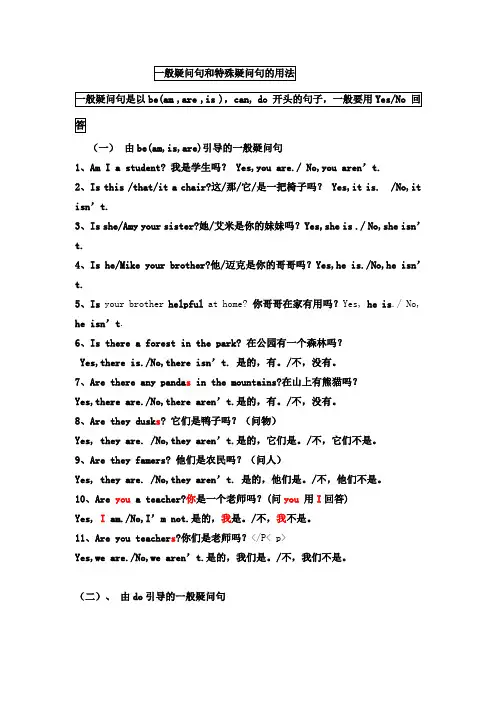
(一)由be(am,is,are)引导的一般疑问句1、Am I a student? 我是学生吗? Yes,you are./ No,you aren’t.2、Is this /that/it a chair?这/那/它/是一把椅子吗? Yes,it is. /No,it isn’t.3、Is she/Amy your sister?她/艾米是你的妹妹吗?Yes,she is ./ No,she isn’t.4、Is he/Mike your brother?他/迈克是你的哥哥吗?Yes,he is./No,he isn’t.5、Is your brother helpful at home? 你哥哥在家有用吗?Yes, he is./ No, he isn’t.6、Is there a forest in the park? 在公园有一个森林吗?Yes,there is./No,there isn’t. 是的,有。
/不,没有。
7、Are there any panda s in the mountains?在山上有熊猫吗?Yes,there are./No,there aren’t.是的,有。
/不,没有。
8、Are they dusk s? 它们是鸭子吗?(问物)Yes, they are. /No,they aren’t.是的,它们是。
/不,它们不是。
9、Are they famers? 他们是农民吗?(问人)Yes, they are. /No,they aren’t. 是的,他们是。
/不,他们不是。
10、Are you a teacher?你是一个老师吗?(问you 用I回答)Yes, I am./No,I’m not.是的,我是。
/不,我不是。
11、Are you teacher s?你们是老师吗?</P< p>Yes,we are./No,we aren’t.是的,我们是。
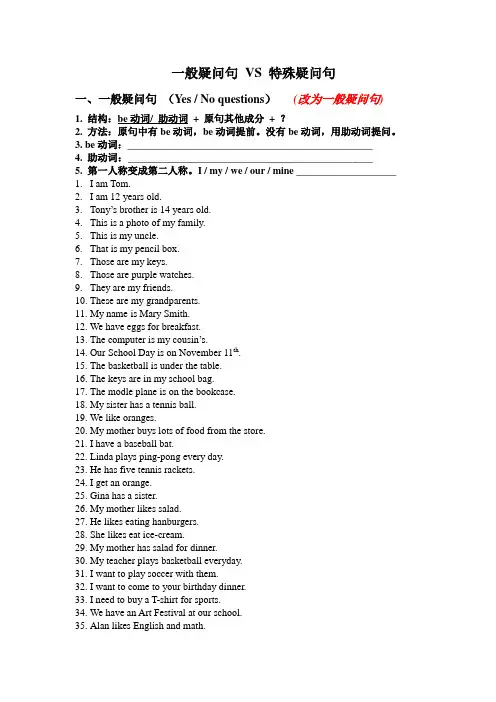
一般疑问句VS 特殊疑问句一、一般疑问句(Yes / No questions)(改为一般疑问句)1. 结构:be动词/ 助动词+ 原句其他成分+ ?2. 方法:原句中有be动词,be动词提前。
没有be动词,用助动词提问。
3. be动词:_________________________________________________4. 助动词:_________________________________________________5. 第一人称变成第二人称。
I / my / we / our / mine ____________________1.I am Tom.2.I am 12 years old.3.Tony’s brother is 14 years old.4.This is a photo of my family.5.This is my uncle.6.That is my pencil box.7.Those are my keys.8.Those are purple watches.9.They are my friends.10.These are my grandparents.11.My name is Mary Smith.12.We have eggs for breakfast.13.The computer is my cousin’s.14.Our School Day is on November 11th.15.The basketball is under the table.16.The keys are in my school bag.17.The modle plane is on the bookcase.18.My sister has a tennis ball.19.We like oranges.20.My mother buys lots of food from the store.21.I have a baseball bat.22.Linda plays ping-pong every day.23.He has five tennis rackets.24.I get an orange.25.Gina has a sister.26.My mother likes salad.27.He likes eating hanburgers.28.She likes eat ice-cream.29.My mother has salad for dinner.30.My teacher plays basketball everyday.31.I want to play soccer with them.32.I want to come to your birthday dinner.33.I need to buy a T-shirt for sports.34.We have an Art Festival at our school.35.Alan likes English and math.二、特殊疑问句(特殊疑问词)(对划线部分提问)1. 结构:特殊疑问词+ be动词/ 助动词+ 原句其他成分+ ?2. 方法:看清楚划线部分,选用正确的特殊疑问词。
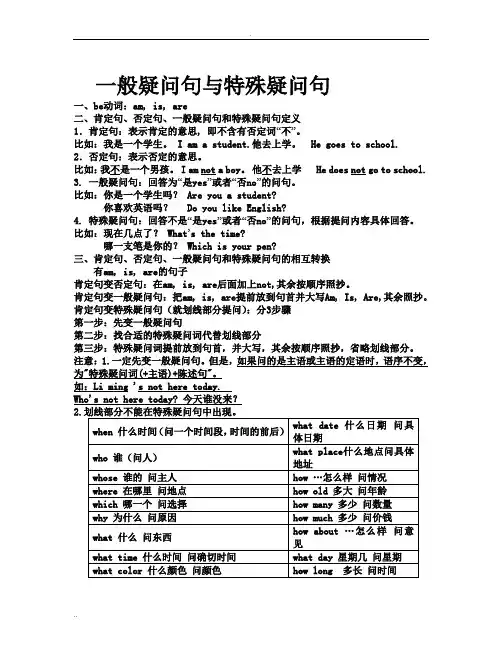
一般疑问句与特殊疑问句一、be动词:am, is, are二、肯定句、否定句、一般疑问句和特殊疑问句定义1.肯定句:表示肯定的意思, 即不含有否定词“不”。
比如:我是一个学生。
I am a student.他去上学。
He goes to school.2.否定句:表示否定的意思。
比如:我不是一个男孩。
I am not a boy。
他不去上学 He does not go to school.3. 一般疑问句:回答为“是yes”或者“否no”的问句。
比如:你是一个学生吗? Are you a student?你喜欢英语吗? Do you like English?4. 特殊疑问句:回答不是“是yes”或者“否no”的问句,根据提问内容具体回答。
比如:现在几点了? What’s the time?哪一支笔是你的? Which is your pen?三、肯定句、否定句、一般疑问句和特殊疑问句的相互转换有am, is, are的句子肯定句变否定句:在am, is, are后面加上not,其余按顺序照抄。
肯定句变一般疑问句:把am, is, are提前放到句首并大写Am, Is, Are,其余照抄。
肯定句变特殊疑问句(就划线部分提问):分3步骤第一步:先变一般疑问句第二步:找合适的特殊疑问词代替划线部分第三步:特殊疑问词提前放到句首,并大写,其余按顺序照抄,省略划线部分。
注意:1.一定先变一般疑问句。
但是,如果问的是主语或主语的定语时,语序不变,为"特殊疑问词(+主语)+陈述句"。
如:Li ming 's not here today.Who's not here today? 今天谁没来?2.例如:1肯定句、否定句和一般疑问句的互换肯定句:This is a book.否定句:This is not a book.一般疑问句:Is this a book?肯定回答:Yes, it is.否定回答:No, it isn’t.2就划线部分提问(变特殊疑问句)This is a book.第一步:变一般疑问句 Is this a book?第二步:找合适的特殊疑问词 Is this what ?第三步:特殊疑问词提前放到句首,并大写,其余按顺序照抄,省略划线部分。
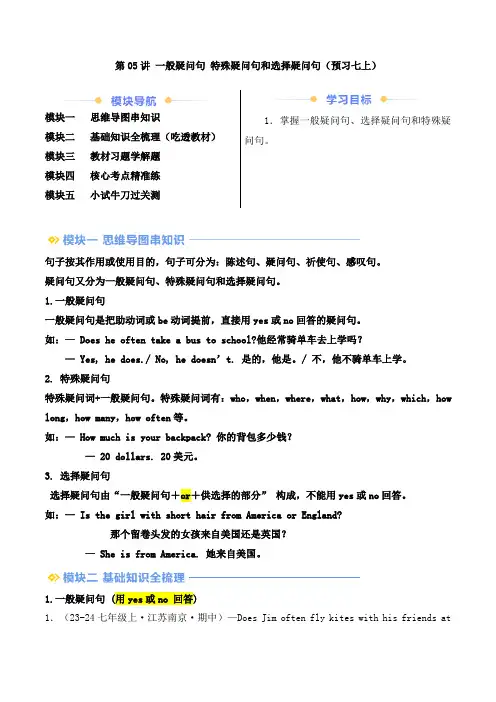
第05讲一般疑问句特殊疑问句和选择疑问句(预习七上)模块一思维导图串知识模块二基础知识全梳理(吃透教材)模块三教材习题学解题模块四核心考点精准练模块五小试牛刀过关测1.掌握一般疑问句、选择疑问句和特殊疑问句。
句子按其作用或使用目的,句子可分为:陈述句、疑问句、祈使句、感叹句。
疑问句又分为一般疑问句、特殊疑问句和选择疑问句。
1.一般疑问句一般疑问句是把助动词或be动词提前,直接用yes或no回答的疑问句。
如:— Does he often take a bus to school?他经常骑单车去上学吗?—Yes, he does./ No, he doesn’t. 是的,他是。
/ 不,他不骑单车上学。
2. 特殊疑问句特殊疑问词+一般疑问句。
特殊疑问词有:who,when,where,what,how,why,which,how long,how many,how often等。
如:— How much is your backpack? 你的背包多少钱?— 20 dollars. 20美元。
3. 选择疑问句选择疑问句由“一般疑问句+or+供选择的部分”构成,不能用yes或no回答。
如:— Is the girl with short hair from America or England?那个留卷头发的女孩来自美国还是英国?— She is from America. 她来自美国。
1.一般疑问句 (用yes或no 回答)1.(23-24七年级上·江苏南京·期中)—Does Jim often fly kites with his friends atweekends?—________. He likes flying kites very much.A.Yes, he is B.Yes, he does C.No, he doesn’t 2. 特殊疑问句(问什么答什么)2.(23-24七年级上·江苏盐城·期末)—________ woman is Daniel’s mother? —The one in the red coat.A.What B.Where C.Who D.Which3. 选择疑问句(选什么答什么)注意:不要错看成一般疑问句。
七年级英语一般疑问句和特殊疑问句练习题Ⅰ.单项选择。
()1.——is your dictionary?——10 Yuan.A. How muchB. How manyC. WhatD. Whose()2.——subjects do you have ?——Seven.A. How longB. How manyC. How muchD. How far()3.——do you like best?——I like math best.A. Which subjectB. What foodC. What colorD.Which sport()4. ——do you like science?——it’s interesting.A. Why; SoB. What; BecauseC. Why; BecauseD. How; Because()5. When the girl her homework?A. does; doesB. does; doC. do; doesD. do; do()6. ——Does he want to go to a movie?——.A. Yes, he doesB. No, he doesC. Yes, he doesn’tD. Yes, she is()7. ——kind of movies do you like?——I like comedies very much.A. What’sB. HowC. WhatD. Why()8. ——are these bananas?——Five dollars.A. What colorB. How aboutC. How muchD. How many()9. ——Can we play football in the street?——No, you . It’s dangerous.A. canB. mustn’tC. mayD. may not()10. ——does he play football?——In the afternoon.A. WhenB. WhereC. HowD. What真题链接()1. ——is your father?Does he still work as an engineer?——Yes, he has been an engineer for thirty years.A. WhoB. HowC. WhatD. Which()2.——does your father go to the fitness center?——He exercises there twice a week.A. How soonB. How oftenC. How long()3.——will the invitations be sent to our guests?——In three days.A. How oftenB. How soonC. How longD. How far()4.——is it from the New Town to the old city centre?——Less than 30 minutes by underground.A. How soonB. How oftenC. How longD. How farⅡ. 按要求完成句子。
33.34.35.36.37.38.______________________________39.There is a village.(改为一般疑问句) ______________________________40.The flowers are red.(对划线部分提问) ______________________________41.Are there any buildings in the village?(作否定回答)______________________________42.There are some small houses in my village.(改为一般疑问句)__________________________43.Is the air clean?(作否定回答) ______________________________44.He is our math teacher.(对划线部分提问) ______________________________45.I can water the flowers.(改为一般疑问句) ______________________________46.I’d like some eggplants.( 改为一般疑问句) ______________________________47.we have English, science, computer and P.E. on Monday.(对划线部分提问)____________________________________________________________48.It’s Friday.(对划线部分提问) ______________________________49.There is a student in the room.(改为复数句子)______________________________50.What’s she like?(年轻又漂亮) ______________________________51.He’s tall and thin.(改为一般疑问句) ______________________________52.Are they young?(作肯定回答) ______________________________巩固练习(三)将下列句子改为一般疑问句,并做肯定和否定回答。
教学过程一.复习预习一般疑问句和特殊疑问句【概念引入】英语中的句子按照句式可以分为陈述句、疑问句、祈使句和感叹句。
一、陈述句用来说明事实或说话人的看法;分为肯定句和否定句。
例如:My name is Lily. 我的名字叫莉莉。
(肯定句)She isn’t a teacher. 她不是一个老师。
(否定句)二、祈使句用来表示请求、命令、劝告和建议等。
例如:Open the door please! 请打开门。
三、感叹句用来表达强烈的感情。
例如:What a beautiful girl she is!她真是个漂亮的女孩儿啊!四、疑问句用来提出问题。
例如:Are you my new teacher? 你是我的新老师吗?本节课,我们将重点讲解疑问句的用法。
二、知识讲解【用法讲解】疑问句可以分为一般疑问句、特殊疑问句、选择疑问句和附加疑问句。
本册书中我们重点学习的是一般疑问句和特殊疑问句。
1.一般疑问句。
(1)什么是一般疑问句?可以用Yes或者No来回答的疑问句是一般疑问句。
一般疑问句读的时候往往要用升调;译成汉语的时候常可以译为“……吗?”。
例如:-Are you a student? 你是个学生吗?-Yes, I am. 是的,我是。
-Can you speak English? 你会说英语吗?-Yes, I can. 是的,我会。
-Do you go to school every day? 你每天都上学吗?-No, I don’t. 不,不是。
(2)如何将陈述句变成一般疑问句?①句中有be动词(am,is,are,was,were等)、助动词(do,does,did,have,had等)或情态动词(can,must,will,may等)时,将其提到句首,句末加上问号即可。
例如:She is a clever girl. 她是个聪明的女孩。
→Is she a clever girl? 她是个聪明的女孩吗?I can swim. 我会游泳。
七年级英语一般疑问句和特殊疑问句练习题Ⅰ.单项选择。
()1.——is your dictionary?——10 Yuan.A. How muchB. How manyC. WhatD. Whose()2.——subjects do you have ?——Seven.A. How longB. How manyC. How muchD. How far()3.——do you like best?——I like math best.A. Which subjectB. What foodC. What colorD.Which sport()4. ——do you like science?——it’s interesting.A. Why; SoB. What; BecauseC. Why; BecauseD. How; Because()5. When the girl her homework?A. does; doesB. does; doC. do; doesD. do; do()6. ——Does he want to go to a movie?——.A. Yes, he doesB. No, he doesC. Yes, he doesn’tD. Yes, she is()7. ——kind of movies do you like?——I like comedies very much.A. What’sB. HowC. WhatD. Why()8. ——are these bananas?——Five dollars.A. What colorB. How aboutC. How muchD. How many()9. ——Can we play football in the street?——No, you . It’s dangerous.A. canB. mustn’tC. mayD. may not()10. ——does he play football?——In the afternoon.A. WhenB. WhereC. HowD. What真题链接()1. ——is your father?Does he still work as an engineer?——Yes, he has been an engineer for thirty years.A. WhoB. HowC. WhatD. Which()2.——does your father go to the fitness center?——He exercises there twice a week.A. How soonB. How oftenC. How long()3.——will the invitations be sent to our guests?——In three days.A. How oftenB. How soonC. How longD. How far()4.——is it from the New Town to the old city centre?——Less than 30 minutes by underground.A. How soonB. How oftenC. How longD. How farⅡ. 按要求完成句子。
一般疑问句与特殊疑问句一、be动词:am, is, are二、肯定句、否定句、一般疑问句和特殊疑问句定义1.肯定句:表示肯定的意思, 即不含有否定词“不”。
比如:我是一个学生。
I am a student.他去上学。
He goes to school.2.否定句:表示否定的意思。
比如:我不是一个男孩。
I am not a boy。
他不去上学 He does not go to school.3. 一般疑问句:回答为“是yes”或者“否no”的问句。
比如:你是一个学生吗? Are you a student?你喜欢英语吗? Do you like English?4. 特殊疑问句:回答不是“是yes”或者“否no”的问句,根据提问内容具体回答。
比如:现在几点了? What’s the time?哪一支笔是你的? Which is your pen?三、肯定句、否定句、一般疑问句和特殊疑问句的相互转换有am, is, are的句子肯定句变否定句:在am, is, are后面加上not,其余按顺序照抄。
肯定句变一般疑问句:把am, is, are提前放到句首并大写Am, Is, Are,其余照抄。
肯定句变特殊疑问句(就划线部分提问):分3步骤第一步:先变一般疑问句第二步:找合适的特殊疑问词代替划线部分第三步:特殊疑问词提前放到句首,并大写,其余按顺序照抄,省略划线部分。
注意:1.一定先变一般疑问句。
但是,如果问的是主语或主语的定语时,语序不变,为"特殊疑问词(+主语)+陈述句"。
如:Li ming 's not here today.Who's not here today? 今天谁没来?2.例如:1肯定句、否定句和一般疑问句的互换肯定句:This is a book.否定句:This is not a book.一般疑问句:Is this a book?肯定回答:Yes, it is.否定回答:No, it isn’t.2就划线部分提问(变特殊疑问句)This is a book.第一步:变一般疑问句 Is this a book?第二步:找合适的特殊疑问词 Is this what ?第三步:特殊疑问词提前放到句首,并大写,其余按顺序照抄,省略划线部分。
What is this?没有am, is, are的句子,肯定句变否定句:在主语后面加上do not或者does not,其余按顺序照抄动词用原形肯定句变一般疑问句:在句首加do或者does并大写,其余照抄。
注意:动词用原形肯定句变特殊疑问句(就划线部分提问):分3步骤第一步:先变一般疑问句第二步:找合适的特殊疑问词代替划线部分第三步:特殊疑问词提前放到句首,并大写,其余按顺序照抄,省略划线部分。
注意:1.一定先变一般疑问句。
但是,如果问的是主语或主语的定语时,语序不变,为"特殊疑问词(+主语)+陈述句"。
2.划线部分不能在特殊疑问句中出现。
非单三时用do, 单三时用does非单三肯定句:I like English.一般疑问句:Do you like English?否定句:I do not like English.三单肯定句:He likes English.一般疑问句:Does he like English?否定句:He does not like English.就划线部分提问:I like English.第一步:先变一般疑问句 Do you like English?第二步:找合适的特殊疑问词代替划线部分Do you like what?第三步:特殊疑问词提前放到句首,并大写,其余按顺序照抄,省略划线部分。
What do you like?巩固练习(一)1.She is quiet.(改为一般疑问句) ______________________________2.He is very tall.(对划线部分提问) ______________________________3.Is Mr. Smith tall and strong?(作肯定回答) ______________________________4.Is Mr. Carter tall?(作否定回答)______________________________5.She is young. She is pretty.(合并为一句) ______________________________6.Is she active?(作否定回答) ______________________________7.She’s very kind and pretty.(对划线部分提问) _____________________________8.That young lady is our principal.(对划线部分提问) ________________________9.Today is Saturday.(对划线部分提问) ______________________________10.We have Chinese and math on Wednesday.(对划线部分提问)___________________________11.Is she young?(作否定回答) ______________________________12.他又高又瘦。
(汉译英)______________________________13.I like vegetables.(改为否定句) ______________________________14.I would like the orange juice.(对划线部分提问)______________________________15.Are the apples sour?(作否定回答) ______________________________16.Sarah: What do you like? Mike: I like peaches.用第三人称转述这组对话。
(1)(汉语提示:迈克喜欢什么?)________________________(2)(汉语提示:迈克喜欢桃子。
)_________________________17.Pork is my favourite food.(对划线部分提问) ______________________________18.Can you play chess?(作肯定回答) ______________________________19.He can do the dishes.(改为一般疑问句) ______________________________20.I can wash the clothes.(对划线部分提问) ______________________________21.Can you set the table?(作否定回答) ______________________________22.There is a big closet.(改为否定句) ______________________________23.There are blue curtains.(改为一般疑问句) ______________________________24.Is this your bedroom?(改为复数形式) ______________________________25.I can see a mirror on the wall.(对划线部分提问)______________________________26.The shelf is near the desk.(对划线部分提问) ______________________________27.Is this your bedroom?(作肯定回答) ______________________________28.There are two curtains.(对划线部分提问) ______________________________29.It’s a new desk.( 对划线部分提问) ______________________________30.Is it a walkman?(作否定回答) ______________________________巩固练习(二)33.There is a small house in my village.(改为复数形式)______________________________34.Is there a lake?(作否定回答) ______________________________35.There are some buildings in our school.(改为一般疑问句)_____________________________36.I can run on the grass.(对划线部分提问) ______________________________37.I like this park.(改为否定句) ______________________________38.There are some tall buildings in the city.(改为一般疑问句)_____________________________39.Is there a river in your village?(作肯定回答) ______________________________40.There is a bridge in my village.(改为复数形式)______________________________41.不,没有。
(翻译成英文)______________________________42.I like my village.(改为否定句) ______________________________43.Are there any pandas in the mountains?(作否定回答)______________________________44.There is a village.(改为一般疑问句) ______________________________45.The flowers are red.(对划线部分提问) ______________________________46.Are there any buildings in the village?(作否定回答)______________________________47.There are some small houses in my village.(改为一般疑问句)__________________________48.Is the air clean?(作否定回答) ______________________________49.He is our math teacher.(对划线部分提问) ______________________________50.I can water the flowers.(改为一般疑问句) ______________________________51.I’d like some eggplants.( 改为一般疑问句) ______________________________52.we have English, science, computer and P.E. on Monday.(对划线部分提问)____________________________________________________________53.It’s Friday.(对划线部分提问) ______________________________54.There is a student in the room.(改为复数句子)______________________________55.What’s she like?(年轻又漂亮) ______________________________56.He’s tall and thin.(改为一般疑问句) ______________________________57.Are they young?(作肯定回答) ______________________________巩固练习(三)将下列句子改为一般疑问句,并做肯定和否定回答。